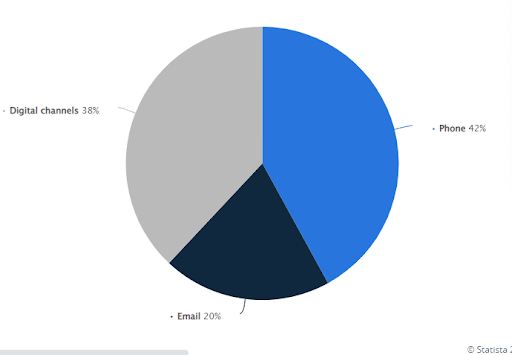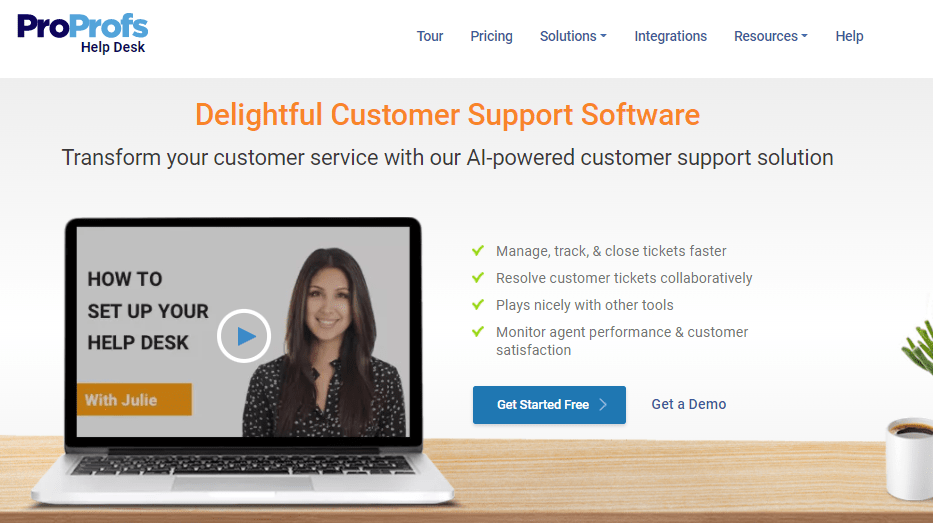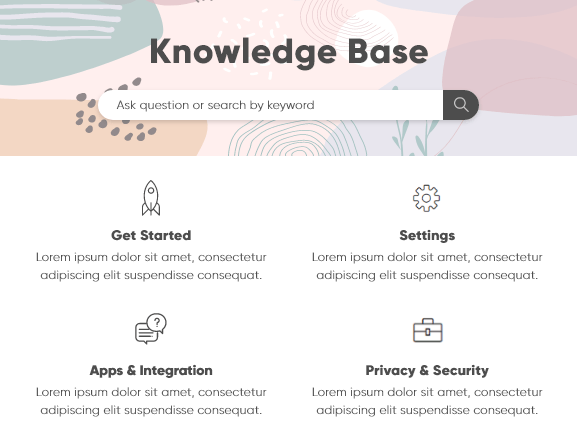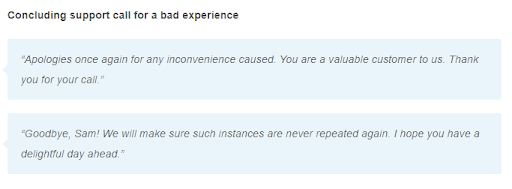The best customer service tips you follow can determine whether customers return to your brand or reach out to your business rivals.
Small business owners have a lot on their plates – endless product inquiries, tiny customer service budget, limited human resources, and so on. Amongst all these mountain-sized challenges, how do you delight and retain your customers?
Well, small businesses need to offer more self-service options to customers, track issues in one place using help desk software, build rapport, and choose communication channels wisely.
But that’s not all.
If you are looking for proven ways to build stronger client relationships, our 20 best customer service tips and strategies will ensure you move closer to your goal. The right combination of these strategies will help your business stand out from the competition and grab eyeballs with awesome service.
Here we go!
What is Great Customer Service?
Great customer service is all about assisting customers in real-time and meeting their unique needs and expectations. But that’s not all. You need to possess the best customer service skills such as empathy, patience, a positive attitude, problem-solving, active listening, and more.
In contemporary times, great customer service has also become more about empowering customers with self-service and minimizing the need for agent intervention.
Why is Customer Service So Important for Small Businesses?
Although you might connect the word “startup” with positive words like entrepreneurship, motivation, or independence, the reality is quite different.
Did you know that 90% of startups or small businesses fail? According to research, around 21.5% of startups fail in the first year, 30% in the second year, and 50% in the fifth year.
While there are multiple reasons that contribute to this failure such as lack of money, trying wrong markets, economic meltdown, etc., poor customer service is also common among such businesses.
Therefore, the quality of customer service you offer can spell the difference between small business success and failure. With delightful support, you can assist customers quickly, encourage them to buy more, and attract more customers through word-of-mouth marketing.
What Are the Qualities of a Great Customer Service Team?
Small businesses have a small support team. In order to delight customers, every team member must put their best foot forward. Here are some top customer service qualities that you must hone together as a team.
1. Clarity Around Roles & Expectations: Every member of your support squad must have different roles and responsibilities. While some may be responsible for IT support, others might have the job to interact with store visitors. Right from day one, ensure all team members have deep clarity around their roles and what is expected of them. Moreover, issue team members with key performance indicators and the targets they need to achieve.
2. Transparent Communication: Your staff members should be comfortable communicating with each other irrespective of their positions. Establish an open-door policy in your small business so that anyone can raise questions, voice their concerns, or simply bring new ideas to the table. This is an effective way to build trust among team members and convey to them that every service rep is valuable.
3. Product/Service Knowledge: An in-depth understanding of your products/services give your team members the confidence they need to interact with customers. When a customer raises a question, they would not want your team to sound as clueless as they are. With the right knowledge and expertise at your fingertips, you can quickly find the right fixes.
4. Patience: Customer service is one such profession that requires the maximum amount of patience. Every email or call you receive from an angry customer can lower your morale and shake you out of your comfort zone. However, as an individual and as a team, you need to stay level-headed and patiently handle difficult situations.
20 Customer Service Tips to Help Your Small Business
1. Hire Customer Service Superheroes
When customers call your business or drop an email, they want to interact with an agent who ticks all the right boxes. Because even if you have the perfect product/service and the best technology in place, ignorant or impolite service reps can only add to customer frustration.
About one in three people believe that the most important aspect of customer service is speaking with a friendly and knowledgeable support agent.
While hiring candidates, there are certain questions that you need to address first.
- How many people do we need for every communication channel?
- What will be the ideal roles and responsibilities of new hires?
- What specific skills should we look for?
- How long do we need to train them?
- What metrics or KPIs will we use to monitor their performance?
Additionally, during the interview process, you must look for candidates who have great interpersonal skills – active listening, leadership, flexibility, empathy, and patience. The right skillsets will ensure that your service reps are able to rise above any challenging situation.
2. Invest in the Best Customer Support Software
Does your small business track issues via email? Are your agents tired of performing the same mundane and manual tasks over and over? Well, there is a solution for you.
There is no substitute for good technology. The best customer support software can help you automate your process and manage multiple communication channels from a single place.
Instead of switching between multiple tools, your agents will be able to track tickets from multiple channels such as email, live chat, help center, web forms, etc., in one place. Moreover, you can even leverage powerful automation capabilities to auto-assign tickets to agents, share automated surveys, as well as email notifications.
Customer support tools are also designed to help managers gain 360-degree visibility into the entire support operations. You can track ticket resolution time, response time, ticket backlogs, customer satisfaction, and other relevant metrics.
3. Handle Difficult Situations With Empathy
Treating customers with empathy is considered one of the best tips for customer service. But is “empathy” just another buzzword? What does it really mean to be empathetic?
Empathy in customer service refers to the action of understanding a customer’s problems, being sensitive to their emotions, and resonating with what they might be going through.
In other words, it means putting yourself into your customer’s shoes. For example, imagine a customer complains that he did not receive the package that he ordered a couple of days ago. Now, instead of simply asking the customer to wait, you can adopt a more empathetic approach.
You can use empathy statements such as, “I understand, this can be extremely frustrating. I would feel the same way too.” This small gesture will not magically solve the problem but will make the customer feel that you respect and understand their emotions.
Read More: 30+ Empathy Statements for Customer Service
4. Build Rapport with Every Customer
Unlike Fortune 500 companies, you must have a small customer base. This puts you ahead in the sense that you can easily speak to every single customer, give them your time, attention, and build rapport.
As a small business owner, you must regularly reach out to your customers, get to know them by name, and personalize interactions to make them feel valued and special.
To build rapport, you can start by talking to customers about their interests. It need not be related to your product but to their general interests such as camping, cooking, watching movies, etc. The idea here is that people feel comfortable talking about themselves and naturally feel connected to you.
You can also build rapport by offering sincere and genuine compliments to your customers. You can compliment customers on their wristwatches, hair, eyewear, or anything that catches your eye. However, you need to make sure you appear professional and do not come across as flirtatious.
5. Know What You Sell
Today, small businesses are expanding so rapidly that the support teams find it difficult to keep up. Within a matter of months, a company can go from a single product to hundreds or thousands of products.
No matter if your business sells toothbrushes or AI-powered software, every support agent must know the product/service inside-out.
Whenever you add a new product or launch a new feature, make sure your customer service team gets adequate training for the same. This best customer service tip will help you prepare a team that has all the answers ready with them.
In addition to this, you must encourage your team to use your products and get a hands-on experience. This will help them relate to the challenges or problems that customers encounter on a day-to-day basis.
6. Use Positive Language
By using positive language, you can dramatically improve the way a customer feels about the interaction.
In customer service, positive language is all bout focusing on what your business can do for the customer rather than what you cannot. Use of positive phrases such as safe, free, imagine, amazing, new, etc., can make all the difference.
Now imagine a customer inquires about a product that is out-of-stock. There are two ways to respond:
Negative Language: “The product is unavailable. We will not be able to give you that product until next month.”
Positive Language: “You will surely get this product in the next month. I can quickly place the order on your behalf and make sure it is delivered to you as soon as it reaches our store.”
As you can see from the above examples, redirecting the conversation towards the positive can change the complete narrative.
7. Save Time with Canned Responses
As a small business, you must be receiving a lot of product or service queries from customers. Now, it becomes impossible to type a complete, personalized response for every chat or email. So what can be the solution?
Canned responses are saved message templates that are prepared for different situations such as customer greeting, feature request, order delivery, returns, refunds, etc.
The use of canned responses can help your team quickly reply to customer chat or email messages and reduce your ticket response time. Here is an example of a canned response that can be used when customers make a feature request.

However, you need to realize that simply copy-pasting these templates is not going to serve the purpose. For better conversations, you need to personalize the message, use positive phrases, and update the content regularly to meet the changing needs.
8. Choose Your Channels Wisely
While corporate giants can afford to offer a buffet of customer service channels, the same is not possible for startups or small businesses. Therefore, you need to be extra careful while picking your channels.
According to a Statista report, 42% of US customers prefer the phone, 20% prefer email, and 38% prefer digital channels to resolve their customer service issues.

Image source: Customer service channels preferred by US customers
Factors such as costs, time, labor, infrastructure, etc., can all influence the channels you can provide to your customers. If you are unsure which ones to keep and which ones to avoid, here are certain questions you should explore:
- What channels do our customers prefer?
- How much manpower do we have to handle the support channels?
- What types of support issues do we typically receive?
- How can we automate our process to reduce the call volume?
- What content or topics should our knowledge base cover?
Read More: Choose the Best Customer Support Channels for Your Growing Business
9. Update Your Knowledge Base Content Regularly
When you search for customer service tips for businesses, you will find a common topic in all search results – “Encourage Self-Service”.
A well-curated knowledge base can have multiple benefits for any small business. It can help you reduce agent workload, save time, empower customers, and most importantly, reduce support costs.
Here are some proven tips and tricks to keep your knowledge base well updated:
- Organize Your Content: Customers will end up contacting your business if they are not able to find what they are looking for. To meet your self-service goals, you must divide the knowledge base articles into proper categories and display them as large icons.
- Identify Topics that Demand Frequent Updates: There are certain topics that might require frequent updates. For instance, as you develop your products, you will have to update the “New Features” section regularly.
- Review Common Customer Queries: Monitor your support ticket history and identify the queries or issues that appear repeatedly. Create new content around these common topics and share them with your customers proactively.
Read More: 10 Best Practices for Creating Knowledge Base Articles
10. Be Approachable
Another retail sales best customer service tip is to appear more approachable to your customers.
When customers walk into your store, they don’t expect you to sing welcome songs or throw a lavish party. They simply want to interact with service reps who have a cheerful, positive, and approachable demeanor.
Here are some tips to appear more approachable to your customers:
- Greet Customers with a Smile: The first time you see eye to eye with a customer who has visited your store, make sure you greet them with a warm and welcoming smile. The same applies when you are speaking to a customer over the phone, as people can easily hear a smile in your voice.
- Ask Relevant Questions: Instead of asking customers irrelevant questions like who they have come with or how many times they have visited your store, you should ask more meaningful questions. For example, you can ask, “What size are you looking for?” or “Is there a particular price or budget that you have in mind?”
- Focus More on Helping Instead of Selling: Customers can sense when you are trying to overtly sell them something just to meet your sales targets. As a service rep, your aim should be to help customers make the best purchase decisions.
11. Keep Company Website Updated
As a small business, your website is the face of your company. There are high chances that people will visit your website first before they even visit your store or buy from you from anywhere else.
Your website must offer in-depth information about what you do, why you do it, and most importantly, what you sell.
You must also monitor your website traffic and track conversions. If there is a major gap between traffic and conversion, it most certainly means that customers are not able to find the right information before making a purchase.
To improve help articles or FAQ pages on your website, you must add feedback surveys on these respective pages. You can ask questions such as, “Were you able to find the information that you were looking for?” or “What can we do to improve our website content?”
12. Share Sincere Apologies
Whenever we are angry at a person, we do not wish to settle for anything less than a sincere, heartfelt apology. The same applies to your customers. They want your business to take responsibility and own up to your mistakes.
A simple “sorry” will not be enough to calm down an angry or upset customer. There has to be a proper meaning, explanation, and remorse behind the apology.
Sincere apologies are a great way to turn any negative situation around and save your business from potential backlash on social media. While your gut response can be to defend yourself or deny the mistake, this strategy never really works.
Instead of indulging in a never-ending blame game, validate your customer’s feelings. Explain what happened using simple words and admit your mistake (if not for what happened but for spoiling the customer’s experience). Moreover, as a best customer service tip, you must diligently explain all the actions your team is taking to fix the problem.
Read More: 20 Customer Service Email Templates for Super-Fast Responses
13. Avoid Redirecting Customers
Customers don’t call you when they are feeling at their best. They only contact you for support when something is not right. And in such a situation, the last thing they would want is to be redirected from one agent or department to another.
Every startup or small business needs to prioritize an important metric called First Contact Resolution. A high FCR rate would mean that customers have to put minimum time and effort to get their issues resolved.
If a customer is bounced around from one department to another, you not only spoil their experience but also lose the hard-earned trust. So how should you aim to resolve a majority of issues in the first attempt?
Well, there are multiple ways to achieve this. You can implement IVR technology to ensure every call is directed to the right person. Additionally, train your team to ensure they can handle the biggest of problems themselves without needing intervention from a senior or manager.
14. Reward Your Loyal Customers
The moment you hear the words “loyalty program”, you might think it’s only meant for corporate giants and multinational companies. However, that is not the case. Even small startups can use creative ways to appreciate and reward their loyal customers.
You will be surprised to know that more than 90% of companies have some sort of loyalty program in place.
Loyalty programs are a great way to retain customers and attract new ones. In addition to offering steep discounts and lucrative offers, you can even make things more interesting by encouraging them to earn reward points.
For example, Atlas Coffee Club offers a simple yet loyalty program where customers can earn reward points for referring their friends, purchasing gifts, and countries they visit (buy coffee from). The small coffee chain allows loyal customers to redeem these points on free shipping or getting discounts on future purchases.
15. Body Language is More Powerful than Words
Did you know that more than 90% of communication is non-verbal? Yes, you heard that right.
Body language plays a crucial role in retail customer service and can make or break any interaction.
Body language cues such as eye contact, hand gestures, smile, facial expressions, etc., have heavy influences on how customers feel when they interact with you.
Every agent should practice good posture as it is typically associated with confidence. Instead of slouching or acting tired, stand upright and use a lot of hand movements. You can even try to mirror and match the customer’s body language to make them more comfortable.
Just like your posture, your tone of voice is equally important. Even when the interaction is not going in the right direction, you need to keep your tone in check. Instead of being overenthusiastic, maintain a professional yet friendly tone.
16. Understand the Pain Points of Your Target Audience
Every business in this world has a target audience that they need to keep in mind while framing any short or long-term customer service strategies. When you know your customers’ pain points, you can start to ease their pain through better service.
Conduct interviews and share online surveys with your prospects and existing customers to identify their unique pain points. Jot them down and analyze the data to see what stands common among them.
Here are some questions you can explore:
- What communication channels does our target audience prefer?
- Do they actively discuss their buying experiences on social media?
- How hard or easy do customers find using our product/service?
- What are the expectations of people when they contact us for support?
- Do customers prefer online or offline shopping?
Understanding these pain points will help you mold your service, meet consumer expectations, and offer proactive support even before customers start complaining.
17. Treat Employees Like You Treat Customers
This is one of the most excellent customer service tips that is often underlooked by a majority of small businesses. Initially, every business has such a sharp focus on customers that they end up ignoring employees.
Your business must treat employees with the same appreciation, respect, and admiration that you have for your customers.
We all have heard the popular saying that “Happiness is contagious.” If your employees are happy at the workplace, they will have all the positive energy needed to deal with every challenge that comes their way.
Take feedback from your employees about everything from the workplace interiors to the training modules you have designed for them. While it is important to establish a culture of healthy competition, you must also empathize with agents when they are not able to give their one-hundred percent.
Read More: 40 Employee Satisfaction Survey Questions That You Can’t Ignore
18. Follow-Up Regularly
Conducting regular follow-ups Is one of the top customer service tips to help your small business.
Follow-ups are a great way to nurture the relationship with your prospects and paying customers. Showing continued interest conveys to customers that your brand values their presence.
When to conduct follow-ups?
- After a customer has bought your product/service: If a customer has invested in your product or service for the first time, you need to follow up with them to understand the challenges they might be facing. You can even share relevant knowledge articles, how-to-videos, and other helpful content.
- When a customer shares a negative review: In today’s social-media-dominated world, even a single tweet has the potential to reach millions of people. Look for customers who have shared negative reviews or comments, follow up with them, take responsibility, and understand what went wrong.
- After a customer complaint is resolved: When you mark a help desk ticket as closed, it does not necessarily mean the job is done. You must follow up with the customer after some time (could be the next day or next week) to check whether they are facing the same problem.
19. Close the Conversation the Right Way
Just like it is important to start a customer service conversation on a positive note, it is equally important to know how to end the conversation. The right closing can leave a lasting impression on customers’ minds and make them feel like you value their time.
In an ideal scenario, this is what a perfect closing should aim to achieve – the agent offers the best solution or advice, and the customer leaves with a delightful support experience.
Here are some tips you can follow to make every interaction memorable:
- Ensure they have gained clarity: (“I hope you have understood the solution that I offered? Do you have any further doubts or questions?”)
- Let them know you are always there: (“If you need any further assistance, feel free to contact us again. I will be more than happy to assist you.”)
- End on a positive note: (“I’m glad we could resolve your issue. It was great speaking with you. Have a good day!”)
Read More: 50+ Customer Service Scripts For Your Team
20. Involve the Entire Company
For small business success, every employee needs to understand customer pain points and expectations. Every member needs to join hands and uplift the company’s customer service efforts.
“Customer service shouldn’t just be a department, it should be the entire company.” – Tony Hsieh
But why is this so important? Shouldn’t salespeople be focused on selling and developers be focused on developing awesome products? Well, yes that is their primary job. However, a thorough understanding of customer issues will allow them to perform their jobs with a more customer-focused approach.
Although some employees might not be customer-facing, they can still offer valuable suggestions. Involve different departments to invite new, unexpected tips to improve customer service. For instance, the accounts team can suggest tips to improve the checkout process or the marketing team can share what customers are talking about the brand on social media.
FREE. All Features. FOREVER!
Try our Forever FREE account with all premium features!
Go from Small to BIG with the Best Customer Service Tips
You must have heard the old adage, “Go big or go home.” Well, it applies to today’s business environment because if your small business is not moving forward, you are destined to fail.
By following these tips for best customer service, you can assist customers in real-time, build long-term relationships, grow your customer base, and expand your business. Remember that customer service should not be about an individual or even a department, it should be the entire company.
You don’t have to incorporate every tip or best practice for your small company. Sit with your team, jot down your priorities, and see what all tips can work for you in the short term. We suggest you use a cloud-based tool like ProProfs Help Desk to automate your support process and delight customers 24×7.
 Tips
Tips
We’d love to hear your tips & suggestions on this article!
FREE. All Features. FOREVER!
Try our Forever FREE account with all premium features!





 We'd love your feedback!
We'd love your feedback! Thanks for your feedback!
Thanks for your feedback!







